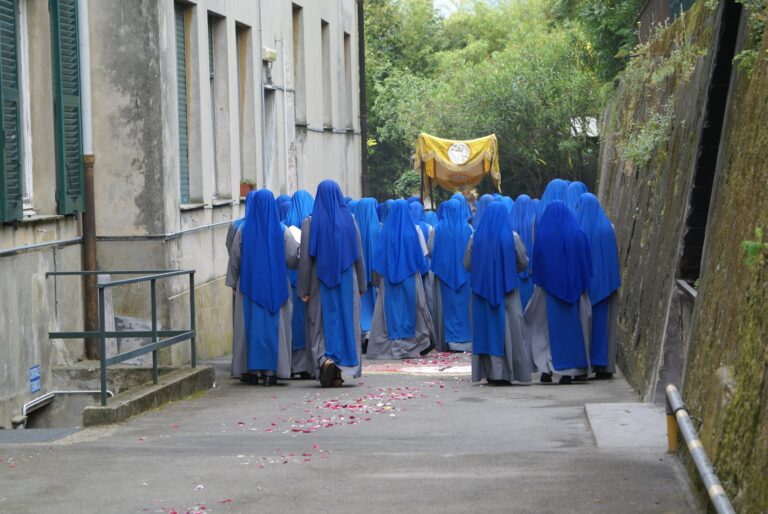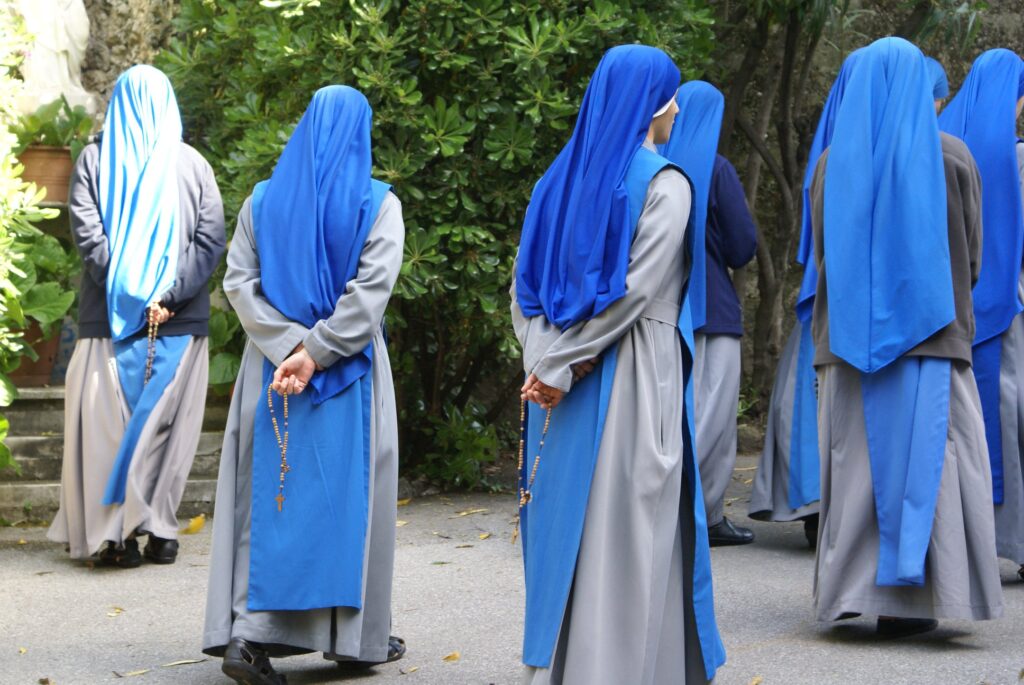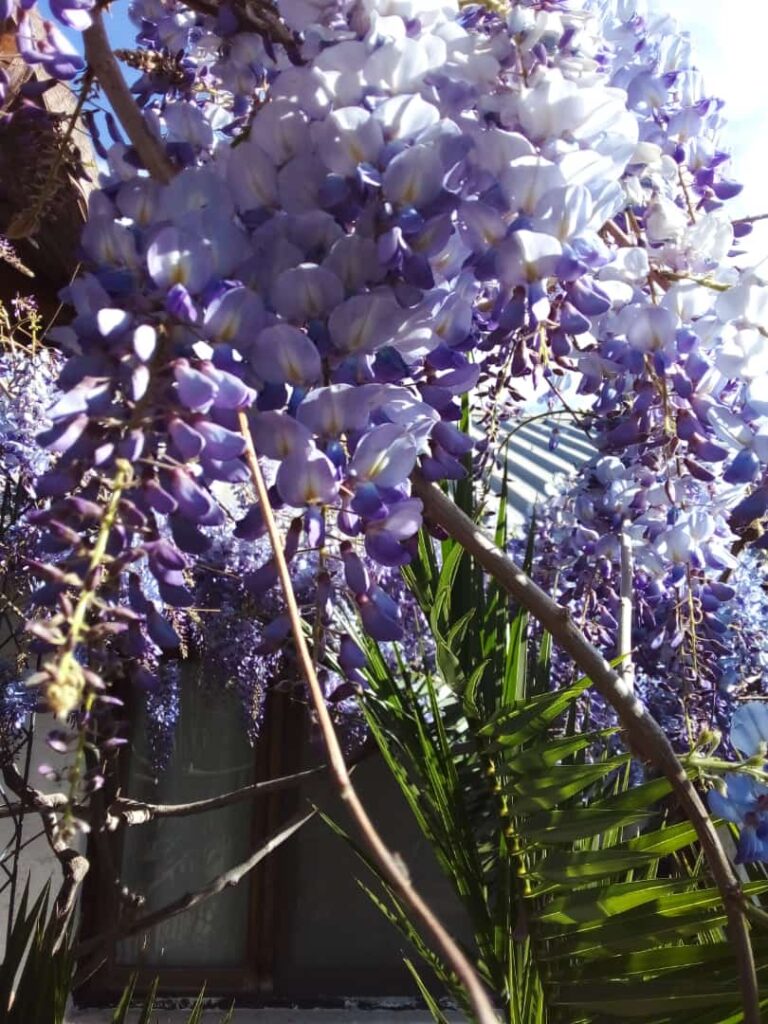Servants of the Lord
and the Virgin of Matará
Our Habit

The Religious Habit
In the Constitutions of the Institute of the Servants of the Lord and of the Virgin of Matará reminded that «the sisters of our Institute must wear the holy habit, which is a sign of his consecration and testimony of their poverty»
The use of the religious habit implies, on one hand, the removal of secular clothes. Such abandonment concretely expresses our non-being of the world, our separation from everything that is not God, “is the means of constantly reminding the religious of their commitment that contrasts with the spirit of the world.”
But also, and more importantly, it entails the aspect of clothing. Hence the imposition of the religious habit:
- speaks of a consecration, in the religious sense of the word, that is, a donation to God.
- means the change of life and mentality (the metanoia of the New Testament), the total surrender to God, the cordial, effective and irrevocable adherence to the Catholic religious tradition.
- also means renouncing the world and material goods.
- It implies that one wants to tend to the perfection of the Christian life, that the religious denies herself, that she carries her own cross, that she dies with Jesus Christ a mystical death.
It is the substantial and profound symbolism of which the Abbot Pinufio says: «Examine what the cross implies, cross under whose sign you must live from now on, because it is no longer you who lives, but who lives in you who was crucified for you».
The habit of “Las Servidoras”

Like most of the female religious Congregations, the “Servants of the Lord and the Virgin of Matará” use different garments for their habit:
- the tunic,
- the scapular,
- the coif and the veil.
The tunic (from the Latin tunica, of uncertain etymology), is the wide and long outer garment; It is grey.
The scapular (from the Latin scapularis, from scapulae, the backs) is a strip or piece of cloth with an opening through which the head is inserted and which hangs over the chest and back; it is blue.
The coif (from the cimbro toc, cap, or from the Basque tauka) is a white linen garment used to cover the head.
The veil (from the Latin velum) is a blessed cloak with which the nuns cover the head and the upper part of the body, usually white for the novices and blue for the professed.
Also the colors of the habit have a particular meaning, since blue corresponds to the cloudless sky and gray to the earth, and for this very reason the blue means the Word and the grey the humanity. Hence the blue scapular, which represents the Divine Word, put over the grey habit, which symbolizes the humanity, is an eloquent statement about the great mystery of the Incarnation, in which the Word was united with our nature and dressed in our flesh

Wisteria
When we see the “Servidoras ” we think of wisteria. Such is the common name of Wistania sinensis, a plant of the Papilionáceas family, an ornamental vine of great development, cultivated in parks and gardens; it blooms profusely in spring, forming beautiful bluish, purplish or white clusters. It is originally from China. The common name in Spanish is glicina that comes from the Greek glykys, meaning sweet.

For the “Servidoras”, as for every consecrated soul, the Revelation, the Word of God, the Holy Scripture is sweet: “So I went up to the angel and told him to give me the small scroll. He said to me, “Take and swallow it. It will turn your stomach sour, but in your mouth it will taste as sweet as honey.” (Rev 10,9-10).
Jesus Christ, the Incarnate Word, is sweet for his wife: “Like an apple tree among the trees of the woods, so is my lover among men. In his shadow I delight to sit, and his fruit is sweet to my taste.” (Cant 2,3).
But the voice of the bride is also sweet for Jesus Christ, who says to her: “My dove in the clefts of the rock, in the secret recesses of the cliff, Let me see your face, let me hear your voice. For your voice is sweet, and your face is lovely.” (Cant 2,14).
Sweet is, finally, the Blessed Virgin, because she is Mother and Queen of Mercy, as the Church sings to her in the Salve: Oh most clement, oh merciful, oh sweet Virgin Mary!
Likewise, the “Servidoras” remind us of the wisteria because of the great number with which the Lord has blessed them, because they always walk together, because despite their apparent fragility they show enormous resistance and because being fine and delicate, nevertheless, they know bloom even in the house of the poor filling them with a very delicate perfume.
And as if that were not enough, they carry on their hearts the replica of the Cross of Matará.
In each Servant there should be a love for her Habit, it should be like her skin, so that united to the Incarnate Word, who united Heaven and Earth, she may flower into all kinds of good works and be for all the good scent of Christ (2 Cor 2:15).
Swallows, (from lat. hirundo, -inis = for walking), are a very common bird from the beginning of spring to the end of summer, which migrates in search of temperate countries…
It is about fifteen centimeters from the head to the tip of the tail, a black, short, and spiked beak, a reddish forehead and beard, a bluish-black body above and white below,
Pointed wings and a long, deeply forked tail. They are elegant, beautiful, graceful in their movements and soft. They are musical, songbirds: their most common song is a “tsuit-tsuittsuit”, which they emit both when perched and when in flight.
Swallow, is the common name given to several species of a family of passerine birds that are distinguished by their elongated and pointed wings, rounded head, and small legs. Like the Alpine swift (to which they are not related), they feed on insects in flight, and although swallows have short beaks, their mouths are large. The family has a cosmopolitan distribution and has 80 or 85 species (the inclusion in this group of some related species has not been determined). They are gregarious and some species even nest in colonies. … The barn swallow, distributed in both the European and American continents, is probably the most abundant species of those known as swallows, which symbolize good luck and the arrival of spring. They use mud to build open nests in or on buildings, bridges, breakwaters, and other structures. …
The Swallows


I (fr. Buela) compare our sister Servants of the Lord and of the Virgin of Matará, of the Ukrainian Byzantine rite, to swallows:
- Because of the color of their habit, which must be black, because it is the custom in Ukraine.
- Because there are always many, just as there are many vocations that God has given us in Ukraine.
- Because they travel long distances, leaving their homes and going to faraway places to mission.
- Because they always sing. Ukrainian “Servants”, like swallows, always sing a lot at liturgy and eutrapelia, and at all times. The confessor of the faith, Bishop Sofronio Dmyterco told me one day: «The Ukrainian people are musical».
- And because they are elegant, beautiful, graceful in their movements and soft in their manners.
- There is no difficulty that scares them, they overcome all difficulties before which they are not intimidated and the song gives them courage and joy in the Lord.
- They symbolize good luck and the arrival of the Eternal Spring, which is Jesus Christ, his Divine Spouse.
- The name “swallow” is used many times in Ukrainian families when the husband calls her wife “swallow” instead of calling her by her name.
- And, in their own way, they represent the Blessed Virgin Mary, “Spiritual Swallow.” As the Byzantine Liturgy beautifully says.
